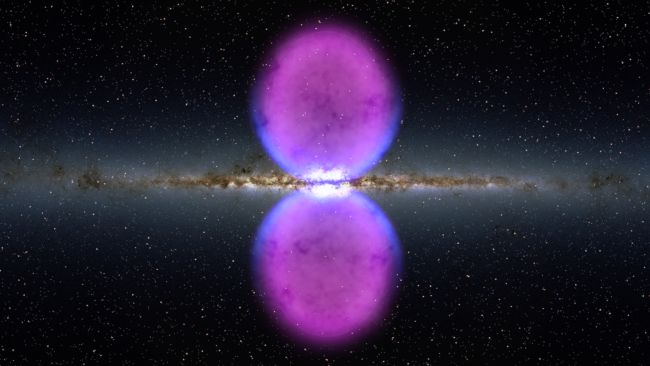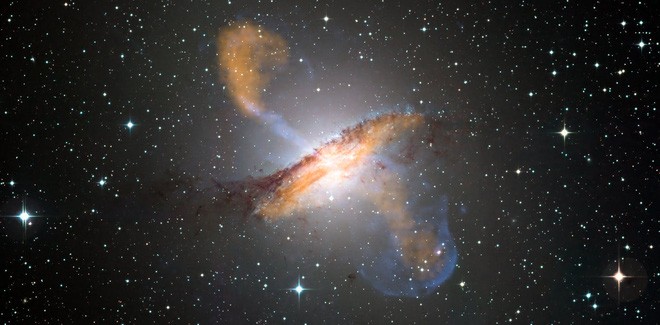The mysterious bubble that appears in the center of the Milky Way galaxy is finally 'decoded'.
In 2010, the Space Agency's Fermi Space Telescope (NASA) discovered two mysterious bubbles located in the central region of the Milky Way. They were named "Fermi Bubbles" by scientists, shaped like the wings of a giant caterpillar, or hourglass shaped. Stretching across the North and South planes of the Milky Way's center, these two giant bubbles of gas, dust and gamma rays are up to 50,000 light-years across, about half the diameter of the Milky Way galaxy.

Fermi bubble
Notably, since the first discovery to date, Fermi Bubbles has caused astronomers around the world to 'headache' due to not finding the origin of this giant gamma ray structure. However, a study just published in the Astrophysical Journal on May 14 showed that there is a link between Fermi Bubble and the activities of supermassive black holes in the center of the band. The Milky Way 6 million years ago.
Through 3D simulation models processed on supercomputers, scientists believe that the Fermi Bubble could be born after a shock wave burst from the supermassive black hole in the middle. center, known as Sagittarius A * (or Sgr A *).
Accordingly, 6 million years ago, when the Sagittarius A black hole sucked matter into the event horizon, it spewed out two streams of high-energy radiation, which flew in the opposite direction from the galactic center with The speed is close to the speed of light.

Supermassive black holes at the center of the galaxy when 'devouring' matter often emit high-energy rays in two directions.
Immediately after these intense streams of radiation were emitted, a shockwave was also created simultaneously, sweeping across the gas clouds in the central region of the galaxy. These clouds of gas, after being compressed and burned by the shockwave, will continually expand into the intergalactic space in both directions, forming the Fermi Bubble. The entire process takes about a million years, the team said.
"A shockwave was immediately created when high-energy radiation 'penetrated' the cloud of gas. After about a million years, Sagittarius A * black hole stopped emitting energy rays. After about In 5 million years, the Fermi Bubble expanded to its present size, "the scientists said.
According to the researchers, the shockwave hypothesis explains several characteristics of the central region of the galaxy, including the extremely high temperature of the Fermi Bubble. At the same time, it also explains why the lower edges of the Fermi Bubble coincide perfectly with the X-ray structures.
You should read it
- Discover the most bizarre black holes in the mysterious space universe
- 10 interesting facts about black holes in the universe (Part 2)
- black hole, white hole, deep hole
- Galaxy merger moment gives glimpse into Milky Way's future
- The first 'wandering black hole' was discovered, 7 times as massive as the sun, and it took scientists 6 years to observe it
- 10 interesting facts about black holes in the universe (Part 1)
- Hubble begins its hunt for hard-to-identify medium-sized black holes
- Black force - a new force in the universe, becomes even more strange
May be interested
- 25 most beautiful Milky Way photos in 2020
 here are the 25 most beautiful milky way photos selected by capture the atlas blog site from a collection of the best night sky photos all over the world from photographers from countries like namibia , new zealand, chile, australia, antarctica ...
here are the 25 most beautiful milky way photos selected by capture the atlas blog site from a collection of the best night sky photos all over the world from photographers from countries like namibia , new zealand, chile, australia, antarctica ... - The largest-ever explosion in the universe created a giant hot-air sphere that could hold 15 Milky Way galaxies
 on february 27, 2020, astronomers at the center released the announcement of the most powerful explosion recorded in the history of the universe since the big bang. the explosion comes from a supermassive black hole at the center of a galaxy in the ophiuchus cluster, 390 million light-years from earth.
on february 27, 2020, astronomers at the center released the announcement of the most powerful explosion recorded in the history of the universe since the big bang. the explosion comes from a supermassive black hole at the center of a galaxy in the ophiuchus cluster, 390 million light-years from earth. - How to turn off notification bubbles on Android
 notification bubble is a feature introduced in android 11 that works much like facebook messenger chat heads. chats pop up on the active screen. if you don't want to use this bubble, you can turn it off.
notification bubble is a feature introduced in android 11 that works much like facebook messenger chat heads. chats pop up on the active screen. if you don't want to use this bubble, you can turn it off. - Revealed photos and configuration of Galaxy S20
 all three models are equipped with infinity-o screens with selfie cameras located in the holes in the center.
all three models are equipped with infinity-o screens with selfie cameras located in the holes in the center. - Do you think the Sun stands still and the Earth revolves around it? Just wrong!
 many people believe that the sun is the center of the universe, it stands still and other planets like earth, venus, mars ... orbit around it. so what about reality? please read the following article to get the most accurate answer.
many people believe that the sun is the center of the universe, it stands still and other planets like earth, venus, mars ... orbit around it. so what about reality? please read the following article to get the most accurate answer. - Fastest star in the Milky Way, speed 8,226,967 km/h
 astronomers at the harvard-smithsonian center for astrophysics have discovered the fastest flying star ever seen in the milky way, setting a record at 8,226,967 km/h.
astronomers at the harvard-smithsonian center for astrophysics have discovered the fastest flying star ever seen in the milky way, setting a record at 8,226,967 km/h. - See stunning works from the art of capturing miniatures with the Milky Way
 thanks to photography, you can 'freeze' a great moment of time, a breathtaking view and share it with everyone.
thanks to photography, you can 'freeze' a great moment of time, a breathtaking view and share it with everyone. - Detecting UGC 2885, a giant spiral galaxy, 2.5 times larger than the Milky Way galaxy
 the hubble space telescope of the united states agency for aeronautics and space (nasa) has discovered a giant spiral galaxy with the size ever recorded, called ugc 2885.
the hubble space telescope of the united states agency for aeronautics and space (nasa) has discovered a giant spiral galaxy with the size ever recorded, called ugc 2885. - Instructions for making very simple soap bubble blowing machines, self-made less than 10 minutes
 would you like to see an extremely beautiful shower of soap bubbles? make this simple device right away!
would you like to see an extremely beautiful shower of soap bubbles? make this simple device right away! - Monster structure discovered that could contain 30 Milky Ways
 (nldo) - the meerkat radio telescope in south africa has just discovered inkathazo, a representative of a group of extremely large but elusive 'cosmic monsters'.
(nldo) - the meerkat radio telescope in south africa has just discovered inkathazo, a representative of a group of extremely large but elusive 'cosmic monsters'.










 12 mysterious deepest holes in the planet
12 mysterious deepest holes in the planet Meteors have the power to destroy 10 billion atomic bombs hitting the Earth at the 'super dangerous' angle, completely eliminating dinosaurs
Meteors have the power to destroy 10 billion atomic bombs hitting the Earth at the 'super dangerous' angle, completely eliminating dinosaurs Misconceptions about biology that many people still believe in.
Misconceptions about biology that many people still believe in. The inventions show the sublime intelligence of Leonardo da Vinci
The inventions show the sublime intelligence of Leonardo da Vinci 12 strange and interesting facts about the universe: How many of you know?
12 strange and interesting facts about the universe: How many of you know? The strange forest area looks like a chessboard when viewed from above
The strange forest area looks like a chessboard when viewed from above